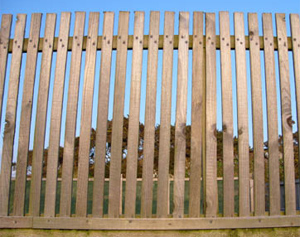 Windbreak
Windbreak
Artificial Windbreaks
The first thing you need to do for your garden is to provide shelter. Here are some suggestions for making artificial windbreaks while you wait for your hedges to grow
The problem: wind and salt
The coasts of Devon and Cornwall are battered every winter - and sometimes at other times of year - by salt-laden gales. Everyone is familiar with salt `burn' - ranging from brown dried patches on leaves to shrivelled-up remains. The hedgerows are full of `wind-pruned' trees that lean over in a permanent bend away from the predominant wind direction.
There are on average about fifteen gales a year. A gale is defined as Force 8 or more (34-40 knots or 39-46mph). The worst period is between December and February. The wind strength alone can bring down branches and even whole trees, with gusts of over 80 knots (92mph] recorded in Cornwall. Most gales come from the south-west, but occasionally Cornwall will get gales from other directions. A cold easterly gale can be very damaging, especially as salt tolerant plants are often not fully hardy to cold. Windbreaks need to be sited with care. A solid barrier will itself create strong turbulence on its leeward side: lower pressure is formed as the wind races over the top of the barrier and draws air away from the back of it. It is much better to use semi-porous material, with the ideal permeability being around 50%. The barrier will give some protection to a distance of about 10 times the barrier height.
Types of windbreak
The most generally used windbreak cover is green netting, sold either by the length or by the roll. These work quite well but they need very careful fastening in order to avoid tearing. It is best to fasten the edges down between battens in order to distribute the strain more evenly between nails. There are also various extruded plastic products which are usually stronger than netting. They can however look very unnatural, so you will need to grow hedging or trailing plants over them as soon as you can. They come in different styles and are usually green or black. One advantage is their long life - some extruded plastic panels last up to ten years.
Another possibility is to use insulating fleece to drape over susceptible plants in winter. You'll have to anchor it well, of course! The best thing is to buy ground pegs or staples.
There are other non-plastic natural windbreaks. Wicker hurdles look good for a fairly short-term barrier. Garden centres sell larch-lap fencing panels, but these are very easily blown over in exposed situations and can cause more damage than they prevent.
Better still make your own windbreak panels. Construct a framework of 3"x2" timber and then cover it with 1½" or 2" battens. Roofing battens are probably the best value for money and come ready tanalised. Space them the same as their width, to give 50% permeability. These windbreak panels are endlessly useful. They can be moved as required, or left to disappear inside a growing hedge.
Whatever type of windbreak you choose, buy good quality material and fasten it down well, or it will not last its first winter. Supporting posts should be buried one-third of their length in the ground.
